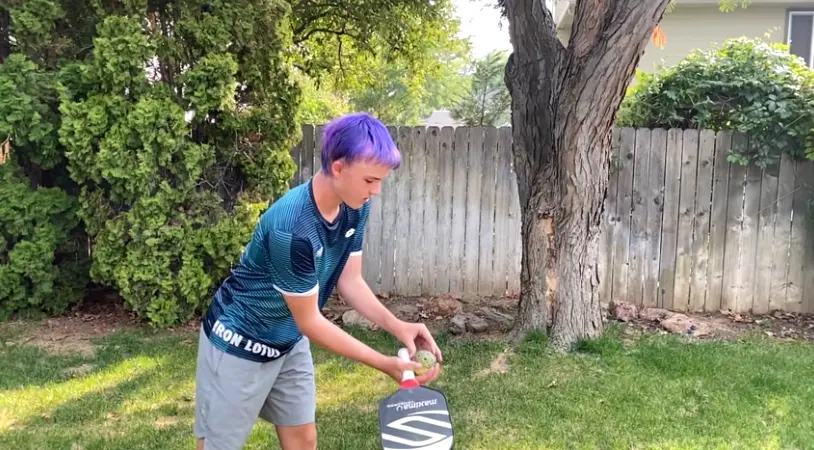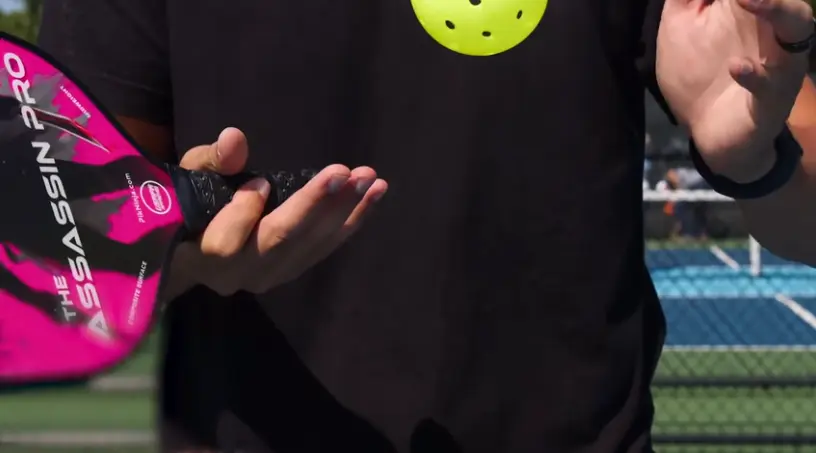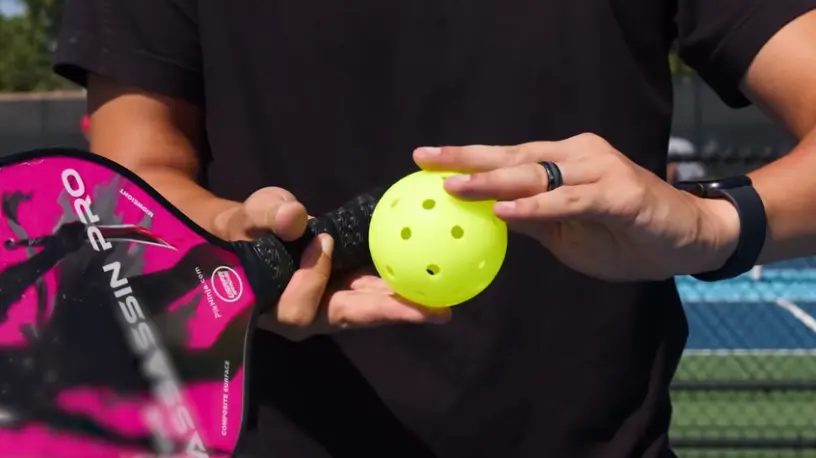Welcome to our comprehensive guide on the chainsaw serve in pickleball! As a passionate pickleball enthusiast, I understand the excitement and thrill that comes with trying out new techniques to gain an edge on the court.
The chainsaw serve has undoubtedly been a hot topic of discussion among players, thanks to its ability to generate remarkable spin and unpredictable ball movement.
In this article, we will delve into the intricacies of the chainsaw serve and explore its impact on the game. We’ll discuss its origins, its rise to prominence through the skills of Zane Navratil, and the subsequent ban imposed by the USA Pickleball Rulebook.
By understanding the nuances of this controversial technique, you’ll gain valuable insights into the evolution of pickleball and the dynamics of competitive play.
So, let’s strap on our paddles and dive into the world of the chainsaw serve, exploring the exhilarating realm of spin in pickleball like never before!
Do Not Forget to Read: Overall Best Pickleball Paddles
What Is The Chainsaw Pickleball Serve?
Pickleball, a rapidly growing sport, has witnessed the emergence of the controversial chainsaw serve.
This unique technique involves spinning the ball against the paddle at the point of release, creating significant spin and making it challenging for opponents to return.

However, the chainsaw serve found itself at the center of a heated debate, ultimately resulting in its ban by USA Pickleball in 2022.The chainsaw serve gained popularity due to its ability to generate unpredictable ball movement, adding a new dimension to the game.

Players utilizing this serve could exploit the spin to their advantage, making it difficult for opponents to anticipate and return the ball effectively. However, concerns were raised about the impact of this serve on the dynamics and integrity of pickleball.
Do Not Forget to Read: Pickleball Spin Serve Rules
Mixed Reactions and Rule Change
The ban on the chainsaw serve elicited a range of reactions within the pickleball community. Some players saw the ban as stifling innovation and limiting the development of advanced skills.
On the other hand, proponents of the rule change believed that the spin should be solely derived from the paddle stroke, preserving the underhand nature of serving in pickleball.
The desire to maintain longer rallies and uphold the spirit of the game played a significant role in the decision to ban the chainsaw serve.
Debating Returnability and Skill Requirement
Central to the debate surrounding the chainsaw serve are questions about its returnability and the skill required to execute and defend against it.
While supporters argue that the serve adds excitement and variety to the game, opponents claim that it hinders the sport’s popularity and leads to an excessive number of aces.
This disagreement reflects a broader discussion about the balance between skill, strategy, and entertainment value in competitive sports.
Professional Play vs. Amateur Play
One notable aspect of the debate is the distinction between professional and amateur play. Advocates for the chainsaw serve, including influential player Zane Navratil, suggest allowing its use in professional matches.

They argue that elite players are capable of executing and countering the serve, adding an extra level of excitement to the game.
However, maintaining the ban in amateur play is viewed as crucial for preserving the integrity and spirit of pickleball at all levels.

Preserving Game Dynamics and Integrity
USA Pickleball’s decision to ban the chainsaw serve aligns with its commitment to preserving the sport’s dynamics and preventing a power-dominated game.
The organization’s restrictions on paddle power and spin reflect a deliberate effort to maintain a balanced and competitive environment. The ban aims to promote longer rallies and prevent excessive speed and power from overshadowing the essence of pickleball.
Implications and Future Outlook
The banning of the chainsaw serve sets a precedent for potential future restrictions on new skills and techniques as pickleball continues to evolve.
It underscores the ongoing challenge of finding the right balance between tradition and innovation in the sport.
The controversy surrounding the chainsaw serve has sparked discussions within the community, highlighting the need to adapt to new techniques while safeguarding the game’s integrity.
The Controversy Surrounding the Chainsaw Pickleball Serve
The controversy surrounding the chainsaw pickleball serve stems from its departure from the intended gentle serves of the game. In pickleball, the emphasis is placed on tactics and kitchen dominance rather than relying on a powerful serve.
The chainsaw serve, with its excessive power, has raised concerns about its impact on the dynamics of the game. The game of pickleball is known for longer rallies and gentler serves, which contribute to its accessibility and appeal.
The introduction of a powerful serve like the chainsaw serve disrupts this balance and challenges the traditional spirit of the game.
Some players, such as Zane Navratil and Morgan Evans, view the chainsaw serve as a smart advantage that can be used strategically.
However, others worry that allowing such powerful serves sets a precedent for banning future innovations that may give players an unfair advantage.
The Ban and Modifications of Chainsaw Serves in Pickleball
Chainsaw serves are currently banned in professional and tournament pickleball play by the USA Pickleball Association (USAPA). Players who attempt to use this tactic in official matches will face penalties.
However, in casual games, players have the freedom to modify the rules with the consent of their opponents. It is essential to communicate and clarify any rule modifications before the game begins to avoid conflicts and misunderstandings.
While the USAPA has established service rules that allow the chainsaw serve, there is strong opposition from individuals who believe that this serve violates the original spirit and strategy of the game.
The determination of the game’s spirit is subjective, with no clear authority defining it. The spirit of pickleball is perceived as fun, competitive, and constantly evolving.
The controversy surrounding the chainsaw serve reflects the diverse perspectives within the pickleball community regarding the use of this technique.
The Importance of Balance and Adaptation in Pickleball

Strategic plays like dinks and the Non-Volley Zone contribute to the pace of the game and promote skillful ball placement. While the serve is a significant aspect of pickleball, it is just one shot among many others, such as the overhead, dink, drive, or lob.
The growth and development of the game rely on players’ ability to emulate and defend against new shots through practice and adaptation.
Maintaining a balance between powerful serves and gentler techniques is crucial to preserve the essence of pickleball and ensure fairness for all players.
The ban on the chainsaw serve aligns with the objective of ensuring fair play and equal opportunities.
Continuous practice, enjoyment, and respect for opponents’ shots contribute to a positive playing experience and the overall growth of pickleball as a sport. Embracing new shots and strategies allows for an evolving and exciting gameplay experience.
Do Not Forget to Read: Best Way To Get Rid Of Tennis Elbow
Conclusion
The chainsaw serve in pickleball has sparked controversy due to its departure from the game’s intended gentle serves and emphasis on tactics and kitchen dominance.
The ban imposed by the USAPA reflects concerns about its impact on the game’s dynamics and integrity.
While some view it as an advantage, others worry about setting a precedent for banning future innovations. Finding a balance between powerful and gentler serves is crucial to preserve the spirit of pickleball.
Embracing new shots while respecting the game’s fundamentals contributes to its growth and evolution. The ongoing discussions highlight the need to adapt while safeguarding the integrity of the game.

Michael Stevenson
Hi, my name is Michael Stevenson and I’m a passionate pickleball player. I’ve been playing the game for many years and I’m pretty highly skilled at it. Pickleball is one of my favorite topics so naturally, I love to write about it.
Whether it’s tips for beginners, guides for experts, reviews of new paddles, or advanced playing techniques – if it relates to pickleball then I have something interesting to write about it. So if you’re looking for entertaining and informative information on the topic of pickleball, look no further than my written works!